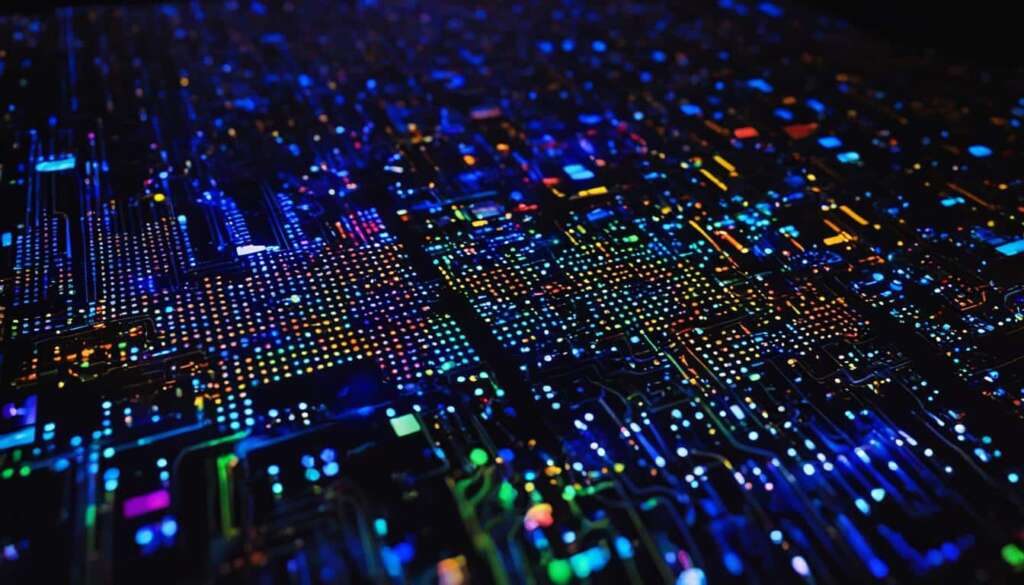Table of Contents
LCD (Liquid Crystal Display) is a type of flat panel display that uses liquid crystals to produce images. It is commonly found in smartphones, televisions, computer monitors, and instrument panels. LCDs have replaced older display technologies such as LED and gas-plasma displays due to their thinner design and lower power consumption. They work by blocking light rather than emitting it.
How LCDs Work
LCDs, or Liquid Crystal Displays, operate through the intricate interplay of various components including a backlight, liquid crystals, and polarizing filters. These elements work in harmony to deliver vibrant and dynamic visual experiences. Let’s delve into the fascinating world of LCD technology and explore how these displays function.
The Components of LCDs
An LCD display comprises several key components:
- Backlight: The backlight provides the necessary illumination for the display to showcase vibrant images and videos.
- Liquid Crystals: The liquid crystals within the LCD panel are responsible for manipulating and rotating polarized light to produce images with precision and clarity.
- Polarizing Filters: Polarizing glass filters are positioned in front and behind the pixels of the LCD display, controlling the orientation and transmission of light.
By effectively combining these essential components, LCDs are capable of delivering stunning visuals in a variety of applications.
Pixel Control and Image Creation
An LCD display is composed of numerous pixels, with each pixel consisting of three subpixels: red, blue, and green. These subpixels can alter their color combinations to create a wide spectrum of hues.
The pixels within an LCD display can rapidly switch on and off, manipulating the presence and absence of light to form images. This advanced pixel control is the foundation of LCD operation, enabling the display to showcase crisp and lifelike visuals.
Polarizer Arrangement and Light Control
The arrangement of the polarizing filters plays a crucial role in LCD operation. By selectively manipulating the orientation of light, the filters determine whether a pixel is on or off. This control over light transmission allows LCD displays to exhibit contrast and depth.
Furthermore, electronic switching of the liquid crystals enables precise control over the amount of light passing through each pixel. This pixel-level manipulation facilitates the dynamic portrayal of images, ensuring optimal visibility and clarity.
LCD Display Types
Not all LCD displays are created equal. There are two primary types: Twisted Nematic (TN) and In-Plane Switching (IPS) displays.
Twisted Nematic (TN) displays are often cost-effective but may exhibit limitations such as reduced contrast ratios and narrower viewing angles.
In-Plane Switching (IPS) displays, on the other hand, offer superior contrast ratios and wider viewing angles. These displays are known for their exceptional image quality and accurate color representation.
Both display types cater to different needs and preferences, providing users with diverse options in selecting their desired LCD technology.
| LCD Operation | Key Components | Advantages |
|---|---|---|
| Pixel Control | Liquid Crystals | Precision in image creation |
| Light Control | Polarizing Filters | Contrast and depth enhancement |
| Display Types | Twisted Nematic (TN) and In-Plane Switching (IPS) | Diverse options for different needs |
Types of LCDs
When it comes to LCD displays, there are several types available on the market. Each type offers different features and characteristics, allowing consumers to choose based on their specific needs and preferences. Let’s take a closer look at some of the most popular LCD display technologies:
Twisted Nematic (TN) Displays
Twisted Nematic (TN) displays are widely known for their affordability. They are often found in budget-friendly devices due to their lower production costs. However, TN displays have their limitations. They tend to have high response times, which can result in motion blur, and their contrast ratios and viewing angles are relatively low.
In-Plane Switching (IPS) Displays
In-Plane Switching (IPS) displays are a step up from TN displays in terms of image quality. They offer better contrast ratios, wider viewing angles, and improved color contrast. IPS displays are particularly popular among professionals who require accurate color reproduction, such as graphic designers and photographers.
Vertical Alignment Panels (VA Panels)
Vertical Alignment Panels (VA Panels) provide a middle ground between TN and IPS displays. They offer decent contrast ratios and viewing angles, making them suitable for general multimedia consumption. However, VA Panels may not deliver the same level of color accuracy as IPS displays.
Advanced Fringe Field Switching (AFFS) Displays
Advanced Fringe Field Switching (AFFS) displays are considered top performers when it comes to color reproduction range. They offer an exceptional color gamut, making them ideal for tasks that require accurate color representation, such as professional photo and video editing. However, AFFS displays may come with a higher price tag compared to other LCD technologies.
When choosing an LCD display, it’s essential to consider your intended use and budget. Whether you prioritize affordability, color accuracy, or wide viewing angles, there is an LCD technology that can meet your requirements.

LCD vs OLED vs QLED
LCDs have long been the dominant display technology, but now they face stiff competition from OLEDs and QLEDs. OLEDs, or Organic Light-Emitting Diodes, offer a significant advantage over LCDs with their use of a single glass or plastic panel that eliminates the need for a backlight. This not only allows OLED devices to be thinner, but it also results in better contrast and wider viewing angles.
However, OLED displays do come with some drawbacks. They tend to be more expensive compared to LCDs, making them less accessible to budget-conscious consumers. Additionally, OLEDs are prone to burn-in, a phenomenon where static images can leave a permanent mark on the display.
On the other hand, QLEDs, or Quantum Light-Emitting Diodes, combine the best of both LCD and OLED technologies. QLEDs are a type of LCD that incorporates a layer of quantum dot film to enhance color and brightness. This gives QLED displays better brightness levels and eliminates the risk of burn-in that OLEDs face. However, when it comes to contrast ratio and deep blacks, OLED displays still reign supreme.
When deciding between LCD, OLED, and QLED displays, consumers should consider factors such as price, picture quality, and their specific needs. While OLED displays offer stunning contrast and viewing angles, they may come with a higher price tag. QLEDs, on the other hand, strike a balance between the two technologies but may fall short in certain areas. Ultimately, the choice between these display technologies depends on finding the right balance of features and affordability that suits individual preferences.
FAQ
What is LCD (Liquid Crystal Display)?
LCD is a type of flat panel display that uses liquid crystals to produce images.
Where are LCDs commonly found?
LCDs are commonly found in smartphones, televisions, computer monitors, and instrument panels.
Why have LCDs replaced older display technologies?
LCDs have replaced older display technologies due to their thinner design and lower power consumption.
How do LCDs work?
LCDs work by blocking light rather than emitting it. They are made up of millions of pixels, and each pixel is controlled by liquid crystals that rotate polarized light.
What are the types of LCD displays?
The two types of LCD displays are passive matrix and active matrix (or TFT display).
What is the superior technology among LCD displays?
The active matrix LCD, or TFT display, is the superior technology as it requires less current to control the luminance of a pixel, resulting in improved screen refresh time.
What components make up an LCD?
LCDs consist of a backlight, liquid crystals, and polarizing filters.
How do the liquid crystals in an LCD display produce an image?
The liquid crystals rotate polarized light to produce an image.
How are different colors created on an LCD display?
Each pixel on an LCD display consists of three subpixels (red, blue, and green) that can change color combinations to create different colors.
What are the two types of LCD displays based on polarizer arrangement?
LCD displays can be either normally on or off, depending on the polarizer arrangement.
What are the differences between twisted nematic (TN) and in-plane switching (IPS) displays?
TN displays are inexpensive but have low contrast ratios and viewing angles, while IPS displays have better contrast ratios and viewing angles.
What other types of LCD displays are available?
Other types of LCD displays include Vertical Alignment Panels (VA Panels) and Advanced Fringe Field Switching (AFFS) displays.
What are OLEDs and QLEDs?
OLEDs (Organic Light-Emitting Diodes) and QLEDs (Quantum Light-Emitting Diodes) are other display technologies that are replacing LCDs.
How do OLED displays differ from LCD displays?
OLED displays use a single panel, do not require a backlight, offer better contrast and viewing angles, but can be more expensive and may suffer from burn-in.
What are QLED displays?
QLED displays are a type of LCD that use a layer of quantum dot film to enhance color and brightness.
Which display technology should consumers choose?
When deciding between LCD, OLED, and QLED displays, consumers should consider factors such as price, picture quality, and specific needs.












